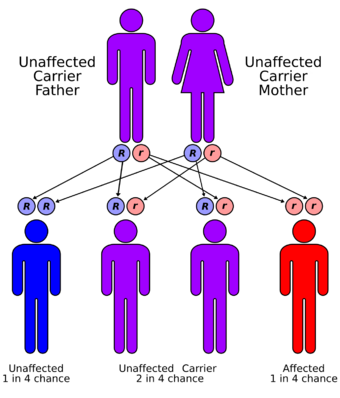Medicine:Blue diaper syndrome
| Blue diaper syndrome | |
|---|---|
| Other names | Other Names: Hypercalcemia, familial, with nephrocalcinosis and indicanuria |
 | |
| Blue diaper syndrome has an autosomal recessive pattern of inheritance. | |
| Medication | none |
Blue diaper syndrome is a rare, autosomal recessive or X linked recessive metabolic disorder characterized in infants by bluish urine-stained diapers. It is also known as Drummond's syndrome, and hypercalcemia.[1][2]
It is caused by a defect in tryptophan absorption. Bacterial degradation of unabsorbed tryptophan in the intestine leads to excessive indole production and thus to indicanuria which, on oxidation to indigo blue, causes a peculiar bluish discoloration of the diaper (indoluria). Symptoms typically include digestive disturbances, fever and visual problems. Some may also develop disease due to the incomplete breakdown of tryptophan.[3]
It was characterized in 1964, and inherited in an autosomal recessive pattern although X-linked recessive inheritance has not been completely ruled out since reported patients have been male.[4]
Since this syndrome is X linked, the chance for a child to receive normal genes from both parents and be genetically normal for that particular trait is 25%. If an individual receives one normal gene and one gene for the disease, the person will be a carrier for the disease, but usually will not show symptoms.[5] Carrier females usually do not display symptoms of the disorder because it is usually the X chromosome with the abnormal gene that is “turned off”.[3] Parents can undergo genetic testing to see if their child will get this syndrome, but most do not find out until they see the symptoms mentioned below.[5]
Signs and symptoms
The signs and symptoms of blue diaper syndrome may include irritability, constipation, poor appetite, vomiting, and poor growth. Some children experience frequent fevers and intestinal infections.[1][3]
Hypercalcemia could be a potential issue in affected children. Some children with blue diaper syndrome have eye or vision issues, particularly underdeveloped portions of the eye, including the cornea and optic disc.[citation needed]
Genetics
Blue diaper syndrome affects males and females equally. The number of people affected in the general population is unknown.[1]
Blue diaper syndrome is thought to be inherited as an autosomal recessive disorder.[citation needed]
Recent research indicates that mutations in the LAT2[6] and TAT1[7] genes might be involved in causing this syndrome.
It is linked to X linked gene and in order for a person to develop it, both parents must carry the gene.[3] This syndrome is diagnosed through clinical evaluation and a fresh urine sample [3]
Diagnosis
A diagnosis is usually made through clinical evaluation, observing detailed patient history then identifying the possible characteristic symptoms and testing fresh urine samples to enhance such evidence.[1]
Treatment
Children with blue diaper syndrome are put on restricted diets. This is in effort to reduce kidney damage. Restrictions include: calcium, protein, vitamin D, and tryptophan. Calcium is restricted to help prevent kidney damage.[3] Examples of food with high levels of tryptophan include turkey and milk.[3] Diets are also expected to be low in protein, which will help prevent symptoms, along with restricting vitamin D intake. Antibiotics may be used to control or eliminate particular intestinal bacteria.[citation needed]
Genetic counseling can also be beneficial, as well as taking part in clinical trials.[8]
References
- ↑ 1.0 1.1 1.2 1.3 "Blue Diaper Syndrome - NORD (National Organization for Rare Disorders)" (in en-US). http://rarediseases.org/rare-diseases/blue-diaper-syndrome/.
- ↑ "Blue Diaper Syndrome" (in en-US). https://rarediseases.org/rare-diseases/blue-diaper-syndrome/.
- ↑ 3.0 3.1 3.2 3.3 3.4 3.5 3.6 "Blue Diaper Syndrome - NORD (National Organization for Rare Disorders)". http://rarediseases.org/rare-diseases/blue-diaper-syndrome/.
- ↑ "Drummond syndrome | Hereditary Ocular Diseases". https://disorders.eyes.arizona.edu/category/alternate-names/drummond-syndrome.
- ↑ 5.0 5.1 "Blue Diaper Syndrome disease: Malacards - Research Articles, Drugs, Genes, Clinical Trials". http://www.malacards.org/card/blue_diaper_syndrome.
- ↑ "Reabsorption of neutral amino acids mediated by amino acid transporter LAT2 and TAT1 in the basolateral membrane of proximal tubule". Arch Pharm Res 28 (4): 421–32. 2005. doi:10.1007/BF02977671. PMID 15918515.
- ↑ "The human T-type amino acid transporter-1: characterization, gene organization, and chromosomal location". Genomics 79 (1): 95–103. 2002. doi:10.1006/geno.2001.6678. PMID 11827462.
- ↑ RESERVED, INSERM US14 -- ALL RIGHTS. "Orphanet: Blue diaper syndrome". http://www.orpha.net/consor/cgi-bin/OC_Exp.php?lng=en&Expert=94086.
External links
- Blue diaper syndrome at NIH's Office of Rare Diseases
| Classification | |
|---|---|
| External resources |
 |

